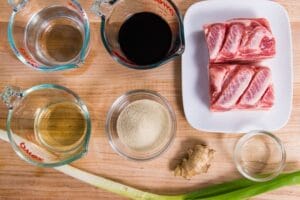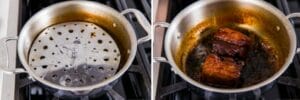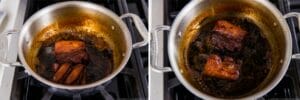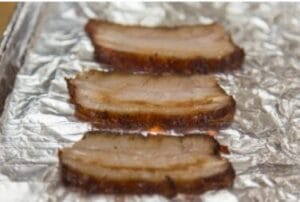There’s nothing quite like a steaming hot bowl of ramen on a cold winter’s day to warm your soul. As I sit here dreaming of my next bowl, my mind inevitably wanders to the melt-in-your-mouth chashu pork ramen that crowns this noodle nirvana.
Chashu pork Ramen has a special place in my heart. Braised for hours in a sweet and salty soy broth, the fatty pork belly transforms into the ultimate umami bomb, sending my tastebuds into overdrive with its rich, savory flavor.
I still remember the first time I tried real chashu, not the sad packaged stuff but thick-cut slabs of glistening pork in a tiny ramen-ya in Tokyo. One bite and I was hooked for life. I knew I had to learn how to make it myself.
After much trial and error, I’ve finally perfected my chashu recipe to rival the ramen shops. The aroma of ginger and garlic fills my kitchen as the pork bubbles away, causing my mouth to water in anticipation. And the finished result? A sublime balance of fall-apart tender meat in a luscious layer of fat, with the sweet notes of mirin and the rounded flavors of soy.
I can’t wait to top my next ramen creation with these slices of porky decadence. I hope you’ll find as much joy in making chashu as I have. Now who’s ready for a bowl?
What is the pork in ramen called ? What is pork chashu ?
Pork chashu, a staple in Japanese cuisine, is a dish that truly captivates the senses. Imagine a slice of pork belly, so tender it seems to dissolve the moment it touches your tongue. This culinary delight is slow-braised to perfection, allowing the flavors of soy sauce, mirin, ginger, and garlic to infuse deeply into the meat. The result is a succulent, umami-rich experience that enhances any bowl of ramen it graces.
The beauty of chashu lies not only in its taste but also in its versatility. Whether served atop steaming noodles or as a main dish, it brings a sense of comfort and satisfaction. It’s no wonder that for many, including myself, the mere thought of this melt-in-your-mouth pork evokes a warm, joyful anticipation. Chashu is more than just food; it’s a craft, an art form where every bite tells a story of tradition and flavor.
Best Chashu Pork Ramen Recipes
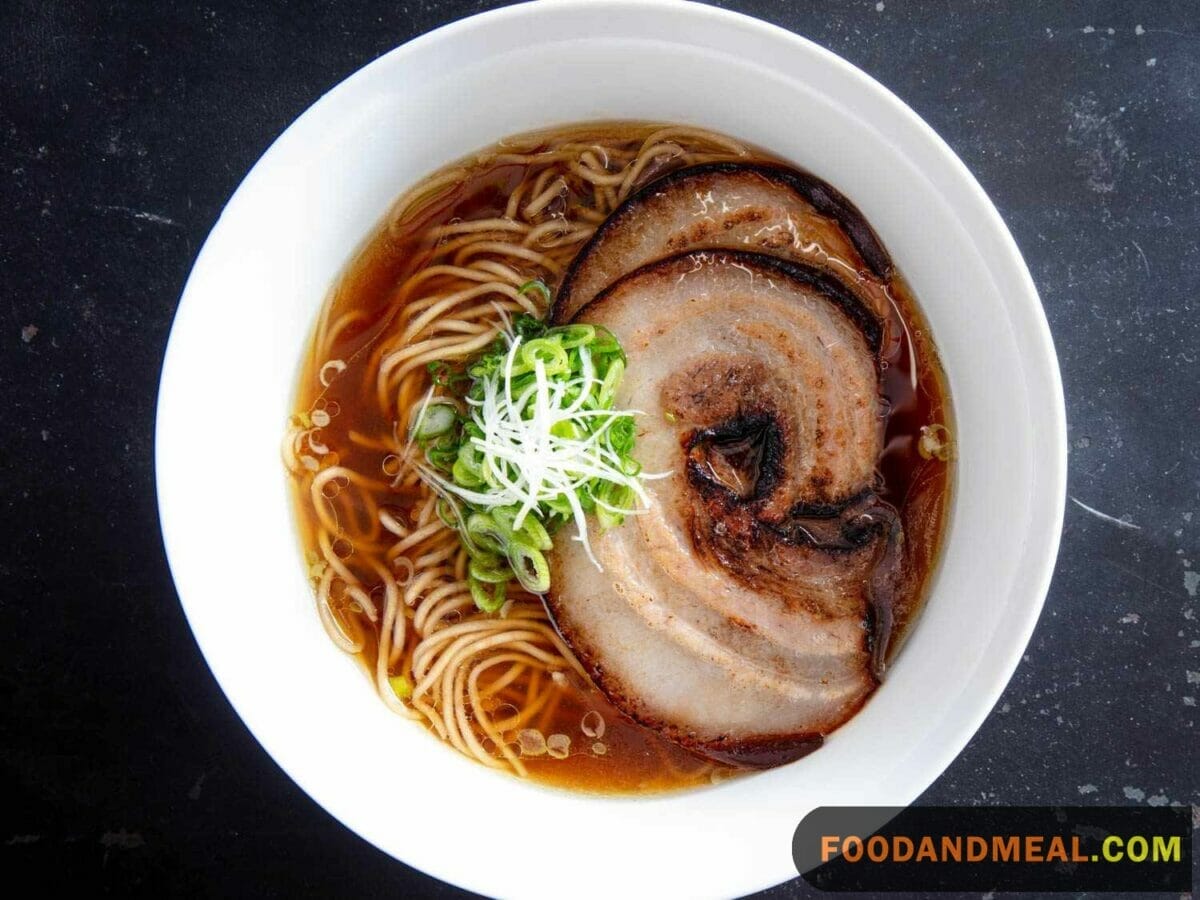
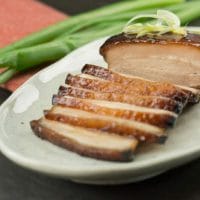
Chashu Pork Ramen
Ingredients
- 1 pound boneless pork belly or shoulder
- Salt
- Freshly ground black pepper
- 2 cups soy sauce
- ¾ cup honey
- ½ cup white wine dried
Instructions
- Season the pork with a little salt and pepper.

- Heat a large skillet over medium heat. When it’s hot, add the pork and brown the meat on all sides.

- Transfer the browned pork to a large stockpot and add the soy sauce, honey, and white wine.

- Bring to a boil over high heat, then reduce the heat to medium and simmer, uncovered, for 25 minutes.

- Remove from the heat and let cool to room temperature. To let the flavors soak in evenly, rotate the pork in the seasoning liquid every 10 minutes or so while it’s cooling. To make this easier, cover the top of the pork with a heavy-duty paper towel; the paper will help the liquid soak evenly into the meat.

- Once the pork is cooled to room temperature, remove it from the seasoning liquid and discard the paper towels. The pork can be cut and used immediately, or wrapped in plastic wrap and stored in the refrigerator for a few days.

Video
Notes
Nutrition
© Food And Meal
This website provides approximate nutrition information for convenience and as a courtesy only. Nutrition data is gathered primarily from the Spoonacular Database, whenever available, or otherwise other online calculators.
Oven-Baked Pork Belly for Ramen
Air Fryer Chashu Pork Ramen Recipe
The air fryer circulates hot air around the pork, rendering the fat and crisping the exterior, creating a delightful contrast to the velvety interior. Wrap the seasoned pork belly tightly, secure it, and place it in the air fryer at 375°F (190°C) for approximately 20-30 minutes, flipping halfway through. It’s a joy to watch the transformation into a caramelized, aromatic masterpiece that, once sliced thinly, elevates your ramen to a heartwarming, comforting bowl of goodness. The beauty of using an air fryer lies in its efficiency and the lighter texture it can impart to the chashu, making the process feel innovative and the meal even more enjoyable.
Slow Cooker Braised Pork Belly Ramen
To begin, you’ll need a good cut of pork belly. Generously season it with salt, sugar, and perhaps some garlic and ginger for aromatic depth.
Roll the belly into a cylindrical shape and tie it with butcher’s twine to hold its form. Place the pork in the slow cooker and pour in a mixture of soy sauce, sake, mirin, and a touch of sugar, which will infuse the meat with rich umami flavors as it cooks. Set your slow cooker on low for several hours, turning the pork occasionally to ensure even cooking and flavor absorption.
Once done, the braised pork should be so tender that it almost falls apart at the touch of your chopsticks. Thinly slice it and lay it atop your ramen, letting the warmth of the broth reheat the meat.
Tips for making Braised Pork Chasu
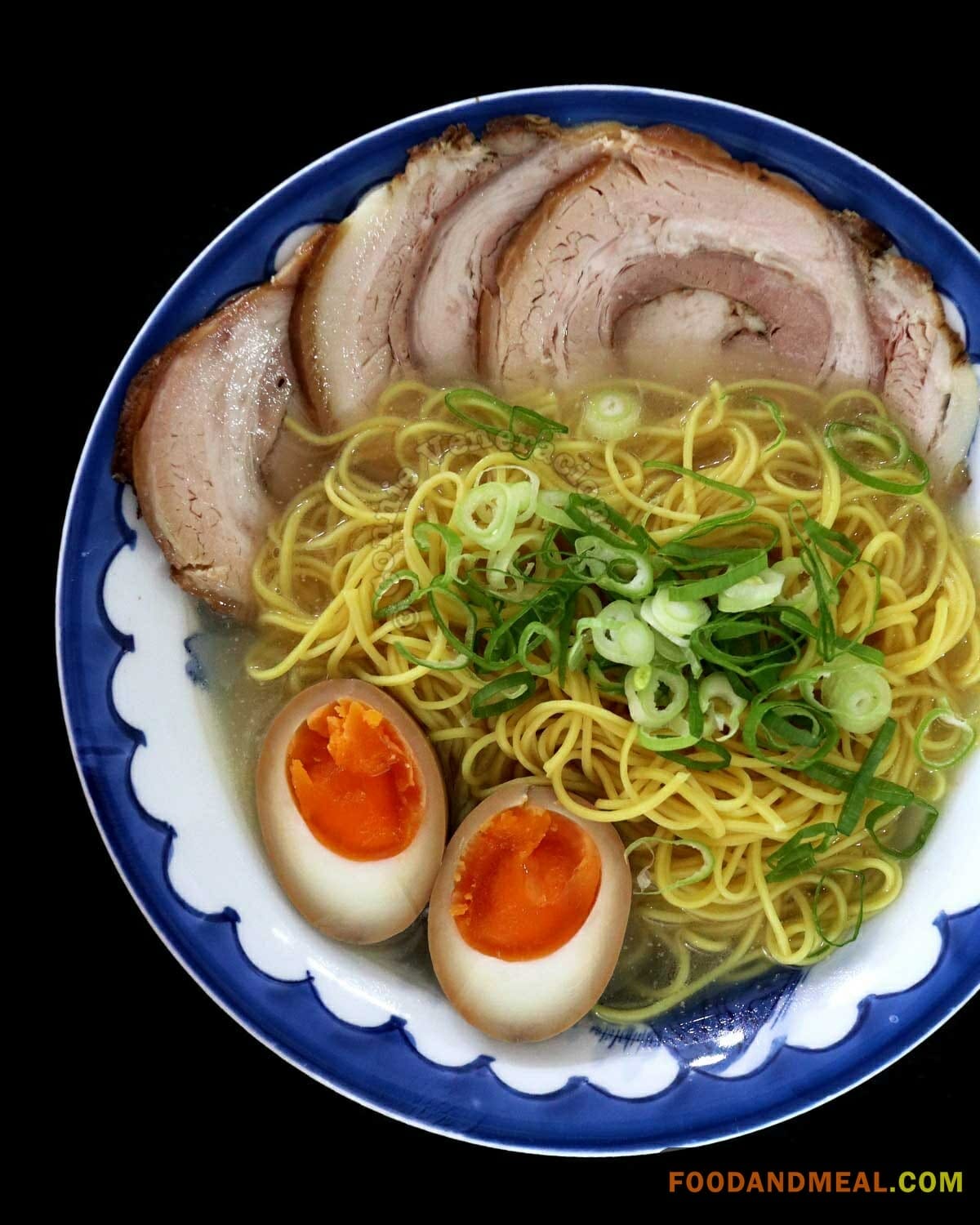
Cooking Notes
Begin by selecting a high-quality cut of pork belly, ensuring it has a balance of meat and fat for flavor and succulence. To infuse the meat with deep, aromatic flavors, marinate it in a blend of soy sauce, mirin, sugar, and perhaps a touch of garlic and ginger, letting the concoction work its magic for several hours or overnight.
When cooking, aim for a low and slow approach. This method allows the pork’s connective tissue to break down without drying out the meat, resulting in a melt-in-your-mouth texture. A dutch oven or a slow cooker could be ideal for this purpose.
Rolling the belly into a log shape and securing it with butcher’s twine before braising can help achieve that iconic spiral slice seen in ramen shops. Once cooked, let it rest before slicing to ensure it retains its juices.
Adding the Chashu to your ramen, remember that it’s not just a topping but a harmonious component. The savory richness should complement the broth and noodles, creating a symphony of flavors and textures.
Serving Suggestions
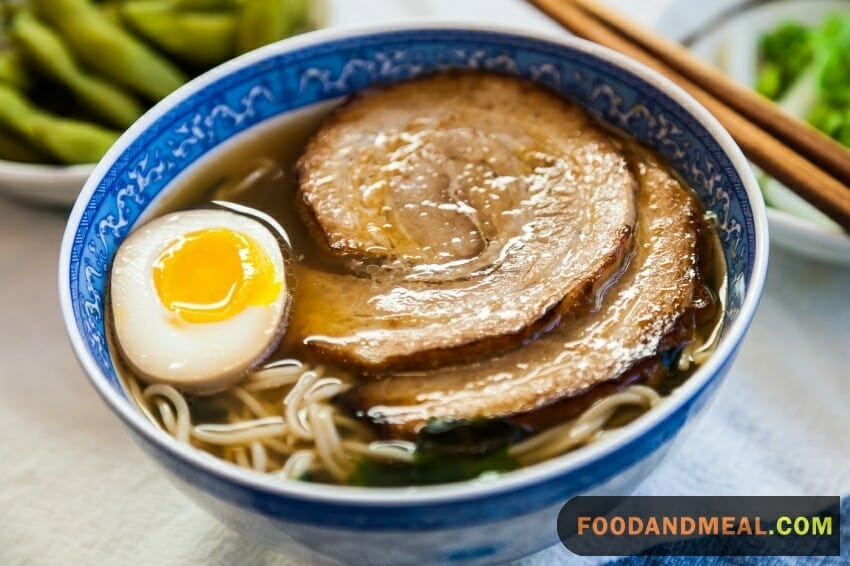
Top 8 FAQs about Pork Chasu
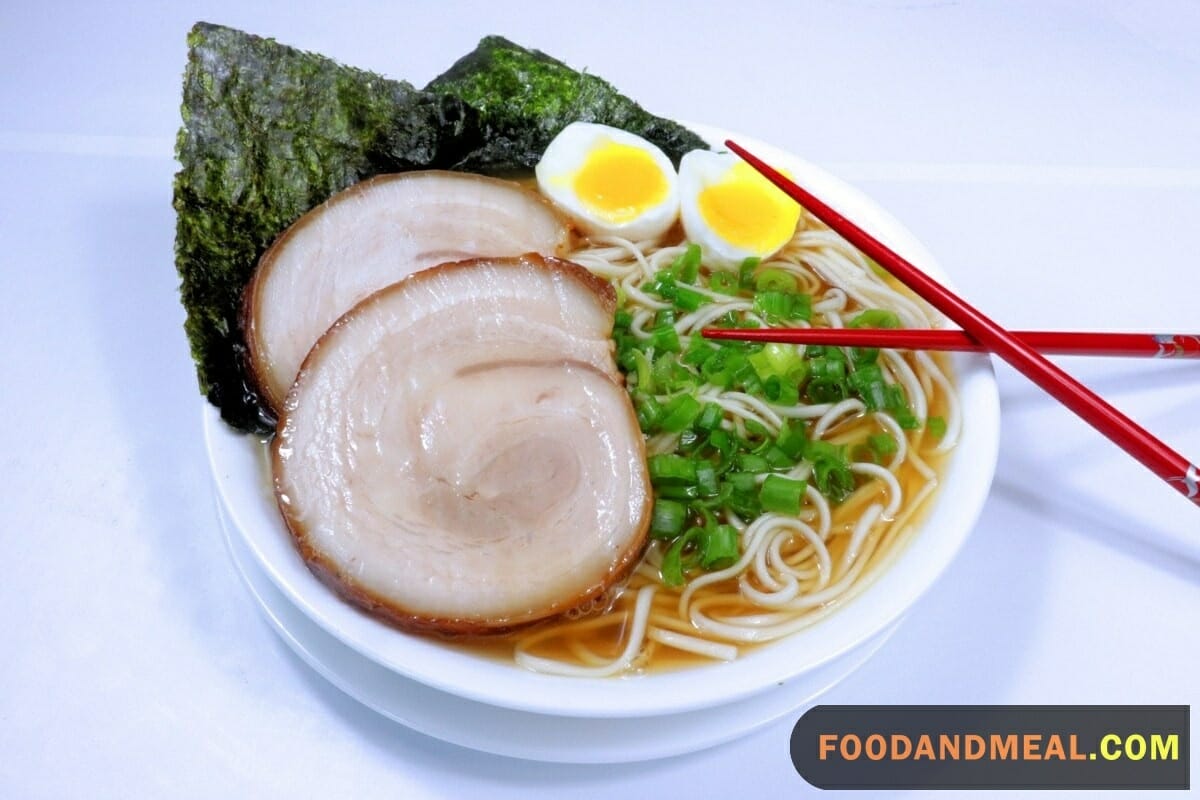
- Do you leave skin on Chashu pork Ramen?
- No, it’s common to remove the skin from Chashu pork belly before preparation to achieve the desired texture and flavor.
- Is Pork Chashu fatty?
- Yes, Chashu pork Ramen is typically made with pork belly, a cut known for its rich marbling, resulting in a flavorful and tender dish.
- What does pork belly chashu taste like?
- Braised Pork belly Chashu has a savory and slightly sweet flavor, with a melt-in-your-mouth texture due to the fat content.
- Can I use a different cut of pork for Chasu?
- While belly is the classic choice, you can experiment with cuts like shoulder or loin for a leaner Chasu.
- Can I store leftover Pork Chasu?
- Yes, you can refrigerate leftover Pork Chasu for up to 3-4 days. Reheat it gently in a best skillet or oven for best results.
- Can I make Pork Chasu in advance for a quick meal later?
- Absolutely! Pork Chasu can be prepared in advance and reheated when you’re ready to serve. It’s a convenient option for busy days.
- What can I do with the leftover marinade from sous vide cooking?
- You can strain and simmer the leftover marinade to use as a flavorful sauce or drizzle over the Pork Chasu when serving.
- Can I freeze Pork Chasu for long-term storage?
- Yes, Pork Chasu freezes well. Wrap it tightly, and it can be frozen for up to 2-3 months. Thaw and reheat as needed.
Conclution
I hope this recipe for chashu pork ramen has inspired you to try making this Japanese favorite at home. The depth of flavor and tender meat are so worth the time and effort. Be sure to check the Food and Meal website for even more ramen recipes and noodle inspiration. And if you make this chashu pork, I’d love to see your beautiful bowls – share your creations with me! Now let’s all go enjoy some steaming noodles. Itadakimasu!
I'm James F Anderson, a noted sous chef from London and a Le Cordon Bleu alumnus. My career began in a Michelin-starred Parisian eatery, where my blend of classic and contemporary cooking, using seasonal ingredients, earned accolades. Recognized in culinary publications and on cooking shows, I’m committed to mentoring aspiring chefs and delivering memorable dining experiences, marking me as a standout talent in the culinary world.




